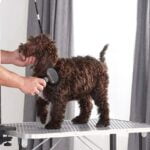Table of Contents
Pet anxiety is a common issue that can affect animals of all ages and breeds. It can manifest in various behaviors, such as excessive barking, destructive chewing, or withdrawal. Understanding how to reduce pet anxiety is crucial for ensuring your pet’s well-being and a harmonious home environment. In this guide, we will explore effective tips and strategies to help your pet feel calm and secure.

Recognize the Signs of Anxiety
The first step in reducing pet anxiety is recognizing the signs. Common symptoms include excessive barking, whining, trembling, hiding, and destructive behavior. Understanding these signs will help you address the root cause of your pet’s anxiety and implement the right strategies. For more details on how to reduce pet anxiety, visit our Signs of Pet Anxiety guide.
Provide a Safe and Comfortable Environment
Creating a safe and comfortable environment is essential for reducing pet anxiety. Ensure your pet has a quiet, cozy space where they can retreat when feeling stressed. This can be a crate, a specific room, or a designated corner with their favorite bed and toys. For tips on setting up a safe space, see our Safe Space for Pets guide.
Maintain a Consistent Routine
Pets thrive on routine. Maintaining a consistent schedule for feeding, walking, and playtime can help reduce anxiety by providing a sense of stability and predictability. Try to keep changes to a minimum and follow a regular routine as closely as possible to reduce pet anxiety.
Exercise and Mental Stimulation
Regular exercise and mental stimulation are key to reducing pet anxiety. Physical activities, such as walks, runs, and play sessions, can help burn off excess energy and reduce stress. Mental stimulation through puzzle toys, training, and interactive games can keep your pet’s mind engaged and alleviate boredom. For exercise ideas to reduce pet anxiety, visit our Pet Exercise Tips.
Positive Reinforcement Training
Using positive reinforcement training techniques can help reduce pet anxiety by building your pet’s confidence and reinforcing good behavior. Reward your pet with treats, praise, and affection when they exhibit calm behavior. Avoid punishment, as it can increase anxiety and stress. For training tips on how to reduce pet anxiety, see our Positive Reinforcement Training guide.
Desensitization and Counter-Conditioning
Desensitization and counter-conditioning are techniques used to reduce pet anxiety by gradually exposing your pet to the source of their fear in a controlled manner. Start with a low level of exposure and gradually increase it while providing positive reinforcement. This helps your pet associate the feared object or situation with positive experiences. For more information on how to reduce pet anxiety, visit our Desensitization and Counter-Conditioning guide.
Use Calming Aids
Calming aids, such as pheromone diffusers, calming collars, and anxiety wraps, can help reduce pet anxiety. These products are designed to provide a sense of comfort and security. Additionally, natural supplements, such as CBD oil and calming chews, can also be effective. Always consult your veterinarian before using any calming aids or supplements to reduce pet anxiety.
Background Noise and Music
Playing background noise or calming music can help soothe anxious pets and reduce pet anxiety. White noise machines, classical music, or specially designed pet relaxation music can mask stressful sounds and create a calming atmosphere. For music recommendations to reduce pet anxiety, visit our Calming Music for Pets guide.
Stay Calm and Positive
Your behavior can significantly impact your pet’s anxiety levels. Stay calm and positive, especially during stressful situations. Pets often pick up on their owner’s emotions, so maintaining a relaxed demeanor can help reassure them and reduce pet anxiety. For more advice, see our Staying Calm with Anxious Pets guide.
Seek Professional Help
If your pet’s anxiety is severe or does not improve with home strategies, seek professional help. A veterinarian or a certified animal behaviorist can provide a thorough assessment and recommend appropriate treatments or behavior modification plans to reduce pet anxiety. For more information, visit our Professional Help for Pet Anxiety guide.
Conclusion: How to Reduce Pet Anxiety
Understanding how to reduce pet anxiety involves recognizing the signs, creating a safe environment, maintaining a consistent routine, and using positive reinforcement. By following these effective tips and seeking professional help when needed, you can help your pet feel calm and secure. For more resources on pet health and wellness, visit our Pet Health and Wellness section.
Frequently Asked Questions about Reducing Pet Anxiety
What are common signs of anxiety in pets?
Common signs of anxiety in pets include excessive barking, whining, trembling, hiding, and destructive behavior. For more information on how to reduce pet anxiety, visit PetMD.
How can I create a safe space for my anxious pet?
Create a safe space by providing a quiet, cozy area with your pet’s favorite bed and toys. This can be a crate, a specific room, or a designated corner. For more tips on how to reduce pet anxiety, visit ASPCA.
Are there any natural remedies for pet anxiety?
Natural remedies for pet anxiety include calming aids such as pheromone diffusers, anxiety wraps, and natural supplements like CBD oil. Always consult your veterinarian before using any natural remedies to reduce pet anxiety. For more information, visit The Spruce Pets.
Can music help reduce pet anxiety?
Yes, playing calming music can help soothe anxious pets and reduce pet anxiety. White noise machines, classical music, or specially designed pet relaxation music can create a calming atmosphere. For music recommendations on how to reduce pet anxiety, visit PetMD.
When should I seek professional help for my pet’s anxiety?
Seek professional help if your pet’s anxiety is severe or does not improve with home strategies. A veterinarian or a certified animal behaviorist can provide a thorough assessment and recommend appropriate treatments. For more information on how to reduce pet anxiety, visit AKC.










